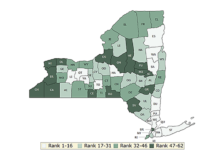Housing quality plays a vital role in our overall health and well-being, yet the relationship between the two is often overlooked. When we think about health, factors like diet, exercise, and medical care tend to take the spotlight. However, the conditions in which we live, particularly the quality of our housing, can significantly impact our health outcomes.
In a new policy brief, we delve into the connections between housing quality and health, shedding light on an often-neglected aspect of well-being. This research goes beyond the general examination and hones in on rural-urban disparities, as well as the intersections of racial/ethnic identity and disability status.
Key Focus Areas and Findings
The policy brief focuses on two crucial indicators of housing quality: incomplete plumbing and incomplete kitchen facilities. These indicators can reveal a lot about the living conditions of individuals and families, and their potential impact on health is worth exploring.
1. Rural-Urban Disparities: The research reveals that rural areas experience a higher proportion of residents living with incomplete kitchen or plumbing facilities compared to their urban counterparts. Shockingly, this translates to over 368,000 individuals in rural areas and a staggering 1.5 million in urban areas living in substandard housing conditions. These numbers are a call to action to address housing quality disparities across locations.
2. Disability Status: The study also highlights that, both in rural and urban settings, a larger proportion of adults with disabilities are living with incomplete plumbing and kitchen facilities compared to those without disabilities. This disparity underscores the urgent need for accessible and suitable housing options for individuals with disabilities, regardless of their location.
3. Rural Challenges: What’s particularly concerning is that a higher percentage of rural residents, regardless of disability status, are facing incomplete plumbing issues compared to their urban counterparts. This is especially pronounced among rural residents with disabilities, who have the highest proportion of substandard plumbing among all groups studied.
4. Racial and Ethnic Disparities: The policy brief doesn’t stop at the rural-urban divide. It also delves into the racial and ethnic dimensions of housing quality. In rural areas, American Indian or Alaska Native communities face particularly severe disparities. Shockingly, these communities have the highest proportions of incomplete kitchen facilities (3.53%) and incomplete plumbing (5.13%), surpassing all other racial and ethnic groups.
Taking Action
The findings of this policy brief underscore the urgent need for attention and action. Substandard housing is not just a statistic; it’s a reality that impacts the health and well-being of millions of individuals and families. As we head into a new year, the timing is perfect to join forces and address these disparities head-on.
If you’re interested in making a difference and contributing to improved housing quality and overall well-being, we invite you to read the full policy brief here. Together, we can advocate for policy changes, raise awareness, and work towards ensuring that everyone has access to safe and healthy living conditions, regardless of where they live or who they are.
Let’s come together to create a healthier future for all.



